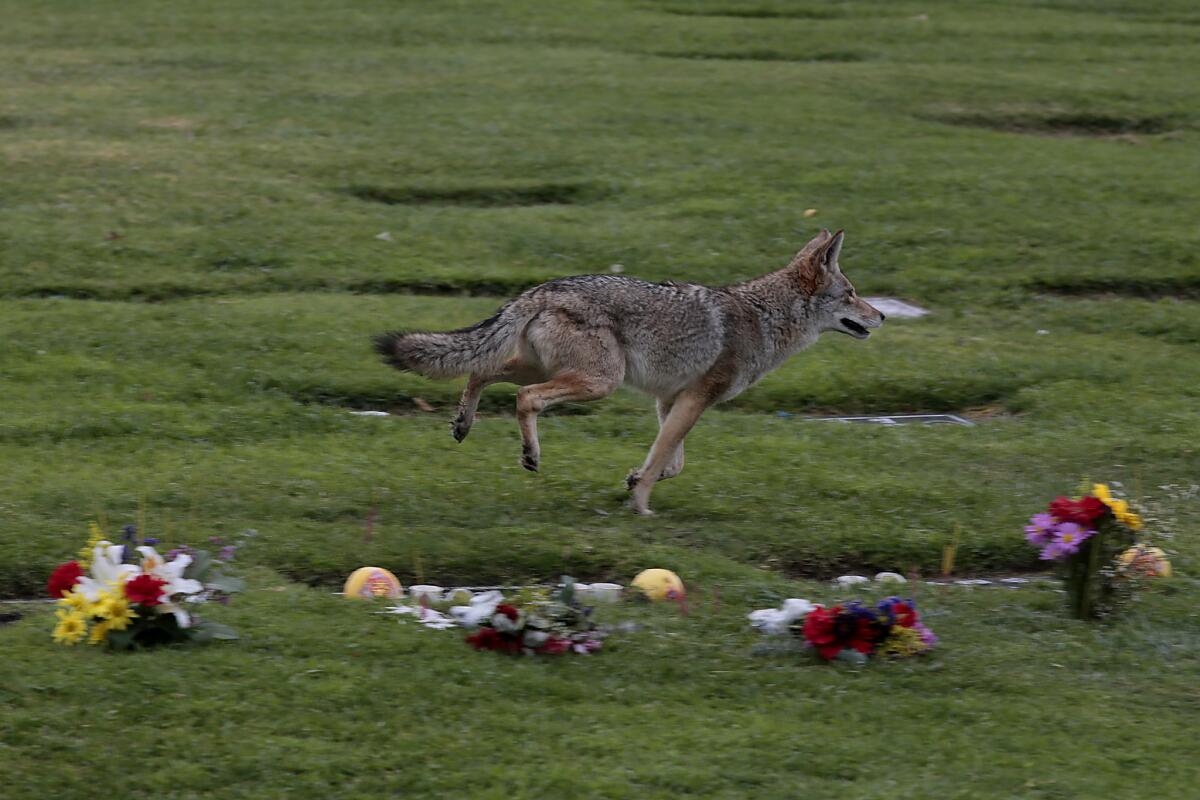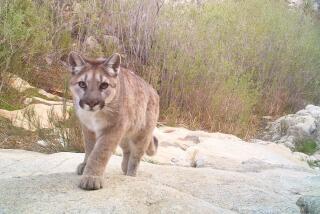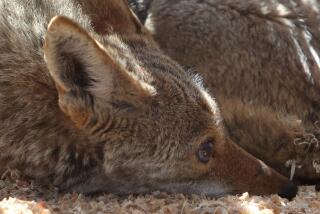Opinion: Does killing urban coyotes create more problems than it solves?

A bold coyote trots past food-laden graves at Rose Hills Cemetery in Whittier.
One night a few months ago, as my husband sat in the backyard, a coyote appeared, so swiftly and silently that one moment it wasn’t there and the next, it was standing on the slope 15 feet away. My husband called me out to look; the creature was a beauty, larger than usual, in full russet-and-gray coat, calmly regarding my husband, who admired it in return.
“Don’t just stand there, harass it!” I yelled, waving my arms and shouting at the beast, which wasn’t all that swift to move. Not until I grabbed the hose and started spraying it did the animal quietly bound back over the fence.
For months afterward, we regularly saw coyotes slipping in and around our neighborhood, Bluebird Canyon in Laguna Beach. Their appearance was more frequent than usual, but coyotes had always been part of the scenery. Bluebird is famous for its landslides, but locally it’s also known as a coyote hangout, just over the ridgeline from a wilderness park.
It’s not uncommon to hear their yipping at night, a chilling sound. To us, it was a welcome reminder of how lucky we were to live in a small community surrounded by open space, though it could admittedly be a nuisance. Across the street, our neighbor’s Maltese had been snatched right out of their yard.
State law doesn’t allow the city to hold an animal long enough for DNA testing. It has to be released right away, or killed.
We haven’t seen any coyotes here for the past three weeks, though. The city took care of that, and I’m not thanking them.
There might be scientists who agree with the way town leaders have been handling its coyote problem, but I haven’t found them. Residents in a couple of neighborhoods complained about bold coyotes that had snatched small pets and appeared on the street each time they were walking their dogs. Things reached a peak when one family reported that a coyote entered the house through an open door, making off with one of its three dogs while a baby slept nearby.
A kind of panic ensued. The city’s response was indiscriminate trapping in the areas where problems had occurred, and the killing of all of those coyotes. Six since the beginning of December.
“I want to take the fight to them,” Councilman Robert Zur Schmiede said, according to a local paper. “We need to be aggressive about this; people are afraid.”
Councilwoman Toni Iseman chimed in: “We’re just lucky we haven’t lost a child yet.”
Lost a child? A child has a much greater chance of being bitten by a dog than by a coyote. According to a Marin County-based coyote-management group called Project Coyote, the chances of dying by coyote are outdone by the chances of being killed by a deer (largely car accidents, but some goring) — or by a fallen refrigerator. This talk of killing didn’t sound much like the city I’ve lived in for more than 30 years, where 79% of residents voted to tax themselves in order to buy a patch of neighboring wilderness so it would remain open for wildlife, rather than becoming another housing tract.
But what’s happening in Laguna is just another story of California’s love-hate relationship with its top animal predators, especially coyotes.
Glendale faced the same debate in 2011, when a pack of seven coyotes moved into an abandoned house. Seal Beach went with trapping and killing in 2014. The state stepped in to eliminate truly aggressive coyotes in Irvine, where several people received minor injuries in attacks, but the city then embarked on an education campaign that has won the state’s praise. It even equipped police with paintball guns to harass the animals.
If there’s a patch of open space, and humans around to provide food, coyotes will generally worm their way in — and that includes Central Park in Manhattan.
It would be too simple to say, “Never kill a coyote. They were here first. Just don’t put out pet food, and yell at them when you see them.” In a local Facebook discussion, one resident of the affected neighborhood said she and her neighbors had been unfairly pigeonholed as carelessly inviting coyotes in, and then heedlessly demanding their deaths. Neighbors already are careful with food and water, she said, yet at least one coyote had its den under a neighbor’s house. “We HAZE and we HAZE and we HAZE,” she wrote in frustration, adding that she wished the city would do something different from trapping and killing, but that something had to be done.
So maybe there is one problem coyote. But six? Of the several wildlife experts I interviewed, all said the troublesome behavior is almost always limited to one coyote that’s become accustomed to the cushy life of suburbia. And that coyote might be a menace that needs to be taken out. This requires some detective work.
According to Lt. Kent Smirl of the California Department of Fish and Wildlife, a problem coyote can often be tracked so that it’s the only one killed. Generally speaking, he said, blanket traps catch younger, dumber animals that aren’t habituated to people; the true wily coyotes are too smart for that, so what’s left is a more problematic population of coyotes.
In fairness, though, tracking isn’t easy. Jim Beres, who’s been overseeing the coyote trapping program for Laguna Beach, notes that coyotes don’t tend to leave much in the way of paw prints on suburban streets. It could be possible to do DNA testing with a trapped coyote, to see whether it’s the one that killed a particular pet, but he said state law doesn’t allow the city to hold an animal long enough for testing. It has to be released right away, or killed.
So what do we have now? Beres figures that the problem coyote is gone with the most recent round of trapping; reports of aggressive coyote behavior have dissipated, so the program is on hold for now, unless there are more problems.
But coyote experts say the city probably has created a worse situation for itself. More coyotes will move into the vacated territory; meanwhile, if the alpha female of the family group was killed, the non-breeding females will begin breeding. Family structures have become unstable, which might lead more coyotes to seek food among the houses. And if Smirl is right, the city has now created a smarter, sneakier population of local coyotes.
Camilla Fox, founder of Project Coyote, said it’s unclear whether the city truly had a problem-coyote issue at all. People tend to misinterpret coyote curiosity as aggression, she said. And even if the city had an animal that had lost too much of its fear of people, that fear usually can be re-installed.
Meanwhile, she said, there’s little evidence that the city has done anything to enforce its laws against feeding coyotes. Most people think of that as purposely leaving out food and water, but it can include leaving fallen fruit on the ground, keeping compost heaps uncovered and failing to clean up the scattered bird seed under feeders.
Project Coyote persuaded the Calabasas City Council not to spend public money on coyote trapping; instead, the nonprofit group has developed a comprehensive plan for managing coyotes. Fox offered to do the same for Laguna Beach — for free.
Instead, the city has committed tens of thousands of dollars to trapping the wildlife, a strange irony for a town that spent millions to preserve the back-country habitat where coyotes live.
We all want wildlife, it seems, we just don’t want it to inconvenience us very much.
Follow the Opinion section on Twitter @latimesopinion and Facebook
More to Read
A cure for the common opinion
Get thought-provoking perspectives with our weekly newsletter.
You may occasionally receive promotional content from the Los Angeles Times.







